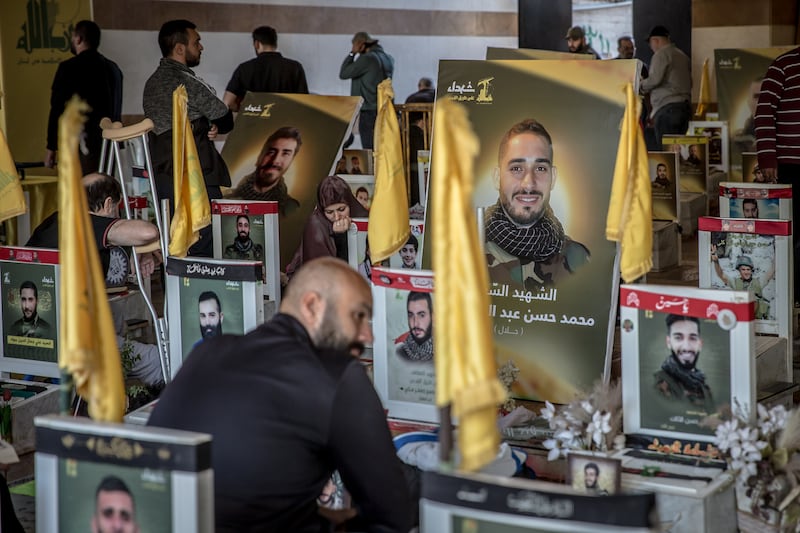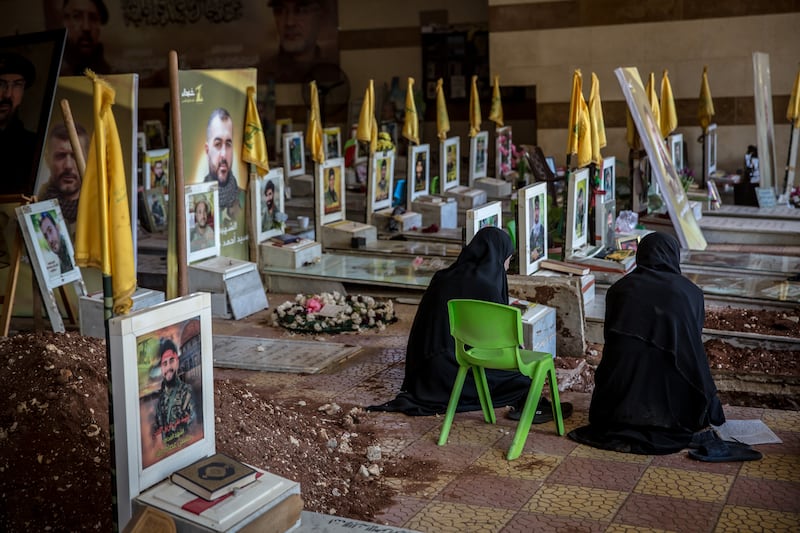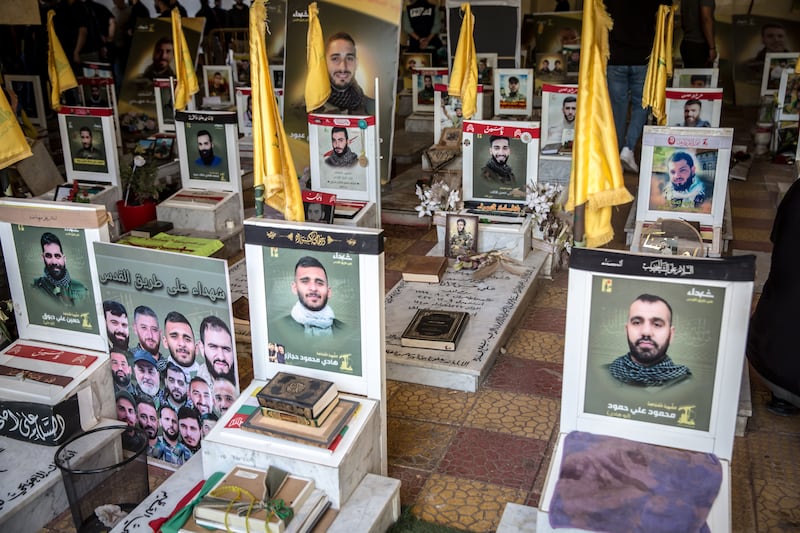In Beirut’s southern suburbs, the area known as Dahiyeh, a civil defence ambulance drives up to a cemetery and a body is taken out. The men gathered to meet it began to shout, in Arabic.
“There is no God but only one God. Peace be upon Prophet Muhammad and his family.
“Humiliation is far away from us. We reply to your call [Imam] Hussein.”
A yellow Hizbullah flag covers the fighter’s coffin, which is carried to an empty grave surrounded by women, holding each other, crying. They read prayers before the coffin is lowered in. An older woman, who appears to be the dead man’s mother, wails “habibi” – “darling”.
READ MORE
The man’s Instagram page – seen later by The Irish Times – gives an insight into the life of one fighter in a militant group designated as a terrorist organisation by the US and others. Hizbullah’s full losses over the past 14 months are unknown. On the day of the burial there are further open graves in the Dahiyeh cemetery, waiting to be filled, while many others are marked with photographs of young fighters who died recently.
The man turned 30 on his last birthday, according to one post on his Instagram page. It described him as a certified public accountant, with many tributes calling him “Dr” because, his page said, he held a PhD in accounting and auditing.
He ran his own business too. He posted about “efficient stock management” and software efficiency. In a video, recorded in a gym, he extolled the importance of exercise.

He also posted grinning selfies with comments like “Life isn’t about finding yourself. Life is about creating yourself” and “Sometimes we must walk through the darkness to find the light.” There is a picture of his mother with the comment “Mothers are the true blessings in life”, and one of him kissing his father’s head with the words: “Parents, trees of compassion ... that protects us from life’s storms.”
In one photograph, he smiled with a group of women holding certificates – they had attended a workshop he held. Beside the picture he wrote: “Young people, we must understand the importance of science and action in building our future and the future of our nation. We have to work hard, strive and always strive for the best ... The future is in our hands, let’s be responsible and seize every opportunity to learn and develop.”
About three weeks before the man died, the man posted a picture of himself grinning beside photographs of Syrian president Bashar al-Assad and Russian president Vladimir Putin, writing “we learned that standing with the truth is the greatest jihad, and that deed and sacrifice in the name of principles is the legacy that we carry with pride in every step”.
He died “on the road to Jerusalem”, tributes said, indicating that he was killed in an Israeli attack.
Friends left messages calling him a “martyr” who “gave [his] blood ... and soul for the sake of Allah and for the defence of [his] homeland” when “he could have lived a normal life”. They called him a “hero”. “History will record their names,” one wrote, about the Hizbullah dead. “You are the honour and pride of Lebanon and with your blood Lebanon will win.”

Hizbullah is notoriously secretive about its military capacity and fighting force.
Nicholas Blanford, the author of Warriors of God, a book about Hizbullah’s history, says the families and friends of fighters might know their role, but “it’s not something [the person] broadcasts”.
“Most of them will have alternative employment, but many of them are full time ... Others could work as a mechanic or whatever. And then, you know, when they get called up to go and do a tour of duty, then off they go.”
Blanford says fighters generally apply to join, “but sometimes people are approached”. A recruiter might even pay attention to children in Hizbullah-supporting areas, noticing how athletic and diligent they are, and considering their family history, before enlisting them when they turn 18. Accounts by the families of fighters suggest minors have participated in military training or become involved through Hizbullah’s affiliated scout group, the Imam al-Mahdi Scouts.
Paul Salem, vice-president for international engagement at the Middle East Institute, a Washington-based think tank, who has written a number of books on conflict in the region, estimates that Hizbullah has about 20,000 regular fighters and between 20,000 and 30,000 reservists. They are recruited from the Lebanese Shia Muslim community, generally in Lebanon’s south and the eastern Bekaa Valley, where Hizbullah has large support. Recruits get benefits including salaries, schooling, and healthcare, he says. If one is killed, their families are supported.
The Lebanese economy and government is in bad shape, so “people need jobs, people need income” he adds. Hizbullah, and its link to Iran, is also “very much part of the ideological identity” for Shias. “It’s not just money, it’s identity as well.”
Hizbullah built a lot of loyalty during the Israeli occupation of Lebanon, which lasted from 1982 to 2000, Salem says.
The number of Hizbullah fighters greatly expanded after 2006, from a maximum of 5,000 to tens of thousands – Blanford puts the current figures as high as 70,000. The 2006 war saw a full-scale Israeli military offensive across much of Lebanon for 34 days, after Hizbullah fighters crossed into Israeli territory and killed three Israeli soldiers, taking two more hostage. “One of the reasons why they expanded so quickly was partly to be ready for a second encounter with the Israelis, because of the inconclusive nature of the end of the 2006 war,” says Blanford. Recruitment was also a tool to increase its political presence within Lebanon, he points out. Hizbullah is a political party and a social movement, as well as a militant group.*
In 2013, Hizbullah confirmed it had been sending fighters to help the dictator Assad stay in power in neighbouring Syria – Hizbullah would be accused of involvement in some of the worst atrocities there. This involvement led to a lowering of recruiting standards, with less vetting, Blanford says. The training became simpler, “and there followed a kind of a Darwinian process where the unlucky and inept were killed off quickly, whilst the luckier and more skilful survived and learned over time”. He says the most senior people fighting in southern Lebanon now are “utterly committed to the cause, very religious, very disciplined, very well trained”.
Having too many fighters has caused a problem though in terms of intelligence leaks, Blanford says. Attacks that seemed to involve intelligence breaches included the September pager and walkie talkie attacks in Lebanon, which killed dozens of people and wounded thousands. Targeted strikes have wiped out many of Hizbullah’s top people, including long-time leader Hassan Nasrallah, who was assassinated in a bombing on Beirut’s southern suburbs on September 27th.
“When you go back to the 1990s when they were a much smaller organisation, their sense of internal security was absolutely airtight ... But after 2006, because they did expand the numbers so quickly, those gaps began to appear,” says Blanford. “Suddenly, if you have a friend of a friend of a friend who could introduce you to a Hizbullah guy, you can begin to cultivate a relationship.”

Now, Blanford says, “Hizbullah has been thoroughly penetrated by Israeli intelligence, which has allowed the Israelis to decapitate the political and military leadership.”
Salem estimates that Hizbullah has lost as many as 3,000 fighters in the latest war, with many more injured. There are no official figures for Hizbullah losses, and it is not clear whether their fighters are always included in the death toll released by Lebanon’s ministry of health, which does include civilians.
Alongside that, the Shia community – which makes up roughly one third of the population of Lebanon and from which Hizbullah draws its support – is almost completely displaced, Salem says: their “villages and towns are being systematically destroyed”.
Both Blanford and Salem say they think it is impossible for Israel to eliminate Hizbullah militarily, though of course it can damage the organisation and weaken it. “I think we’re moving towards a redeployment, withdrawal from the south, a long-term ceasefire ... and Hizbullah will remain but not be rearmed, as it was after 2006,” Salem says.
A problem Hizbullah faces is how to get its people home and where to source money for reconstruction, Salem adds. While some funding could come from Iran, he doesn’t expect it to be much. When it comes to getting its supporters back to normal life, “right now there is not a clear pathway as to how to do that”.
* This article was amended on November 21st to correct an error made in the editing process
- Sign up for push alerts and have the best news, analysis and comment delivered directly to your phone
- Find The Irish Times on WhatsApp and stay up to date
- Our In The News podcast is now published daily – Find the latest episode here





















